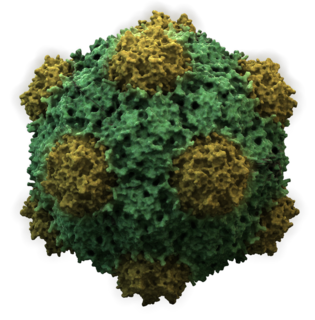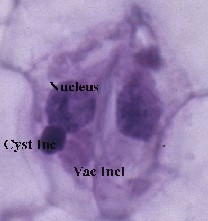
The papaya, papaw, or pawpaw is the plant Carica papaya, one of the 22 accepted species in the genus Carica of the family Caricaceae. Its origin is in the tropics of the Americas, perhaps from Central America and southern Mexico.
A satellite is a subviral agent that depends on the coinfection of a host cell with a helper virus for its replication. Satellites can be divided into two major classes: satellite viruses and satellite nucleic acids. Satellite viruses, which are most commonly associated with plants, but are also found in mammals, arthropods, and bacteria, encode structural proteins to enclose their genetic material, which are therefore distinct from the structural proteins of their helper viruses. Satellite nucleic acids, in contrast, do not encode their own structural proteins, but instead are encapsulated by proteins encoded by their helper viruses. The genomes of satellites range upward from 359 nucleotides in length for satellite tobacco ringspot virus RNA (STobRV).

Bromoviridae is a family of viruses. Plants serve as natural hosts. There are currently 36 species in this family, divided among 6 genera.

Comovirinae is a subfamily of viruses in the order Picornavirales, in the family Secoviridae; its genera were formerly classified in the family Comoviridae. Plants serve as natural hosts. There are currently 62 species in this subfamily, divided among 3 genera.

Papaya ringspot virus (PRSV) is a pathogenic plant virus in the genus Potyvirus and the virus family Potyviridae which primarily infects the papaya tree.

Nepovirus is a genus of viruses in the order Picornavirales, in the family Secoviridae, in the subfamily Comovirinae. Plants serve as natural hosts. There are currently 40 species in this genus including the type species Tobacco ringspot virus. Nepoviruses, unlike the other two genera in the subfamily Comovirinae, are transmitted by nematodes.
Carnation ringspot virus (CRSV) is a plant pathogenic virus of the family Tombusviridae.
Odontoglossum ringspot virus (ORSV) is a plant pathogenic virus that belongs to the family Virgaviridae. It is one of the most common viruses affecting cultivated orchids, perhaps second only to the Cymbidium mosaic virus. It causes spots on leaves and colored streaks on flowers. If a plant is also infected with the Cymbidium mosaic virus, it can lead to a condition called blossom brown necrotic streak.

Prunus necrotic ringspot virus (PNRSV) is a plant pathogenic virus causing ring spot diseases affecting species of the genus Prunus, as well as other species such as rose and hops. PNRSV is found worldwide due to easy transmission through plant propagation methods and infected seed. The virus is in the family Bromoviridae and genus Ilarvirus. Synonyms of PNRSV include European plum line pattern virus, hop B virus, hop C virus, plum line pattern virus, sour cherry necrotic ringspot virus, and peach ringspot virus.

Tobacco rattle virus (TRV) is a pathogenic plant virus. Over 400 species of plants from 50 families are susceptible to infection.

Tobacco ringspot virus is a plant pathogenic virus in the plant virus family Secoviridae. It is the type species of the genus Nepovirus. Nepoviruses are transmitted between plants by nematodes, varroa mites and honeybees. TRSV is also easily transmitted by sap inoculation and transmission in seeds has been reported. In recent cases it has also been shown to appear in bees.
Tomato ringspot virus (ToRSV) is a plant pathogenic virus of the family Secoviridae. It affects species of cucumber, tobacco, tomato, cowpea, among others. It causes ringspots in tobacco plants and raspberries, yellow bud mosaic in peaches, yellow vein in grapes, and stunted growth in gladiolus and Narcissus. Its range is in the temperate regions of North America, especially where its vector, Xiphinema americanum is present. Along with the adult and larval stages of this nematode, the virus is also spread by seed. This type of infection is more common in strawberries and soybeans than any other susceptible plant.
Raspberry ringspot virus (RRSV) is a plant pathogenic virus of the family Secoviridae. It was first described by Cadman in 1958. It causes ringspots in raspberries and strawberries and can cause rasp-leaf symptoms in cherry. It also has been found in many other plants including those in the Vitis and Narcissus genera. There are many strains of the virus, the most important including the Scottish strain, the English strain, and the Lloyd George yellow blotch strain. The Scottish strain is the type virus.

Ilarvirus is a genus of positive-strand RNA viruses in the family Bromoviridae. Plants serve as natural hosts. There are currently 22 species in this genus including the type species Tobacco streak virus.
Carlavirus, formerly known as the "Carnation latent virus group", is a genus of viruses in the order Tymovirales, in the family Betaflexiviridae. Plants serve as natural hosts. There are currently 53 species in this genus including the type species Carnation latent virus. Diseases associated with this genus include: mosaic and ringspot symptoms.
Ringspot, a symptom of various plant viral infections, may refer to:

Alphaflexiviridae is a family of viruses in the order Tymovirales. Plants and fungi serve as natural hosts. There are currently 56 species in this family, divided among seven genera. Diseases associated with this family include: mosaic and ringspot symptoms.

Betaflexiviridae is a family of viruses in the order Tymovirales. Plants and fungi serve as natural hosts. There are currently 108 species in this family, divided among 13 genera in two subfamilies. Diseases associated with this family include: mosaic and ringspot symptoms.

Secoviridae is a family of viruses in the order Picornavirales. Plants serve as natural hosts. There are currently 86 species in this family, divided among 8 genera or not assigned to a genus. The family was created in 2009 with the grouping of families Sequiviridae, now dissolved, and Comoviridae, now subfamily Comovirinae, along with the then unassigned genera Cheravirus, Sadwavirus, and Torradovirus.

Emaravirus is a genus of plant viruses and the sole genus in the family Fimoviridae. The genus has 11 species. The type species European mountain ash ringspot-associated emaravirus is associated with a leaf mottling and ringspot disease of European mountain ash Sorbus aucuparia. It can be transmitted by grafting and possibly mites.











